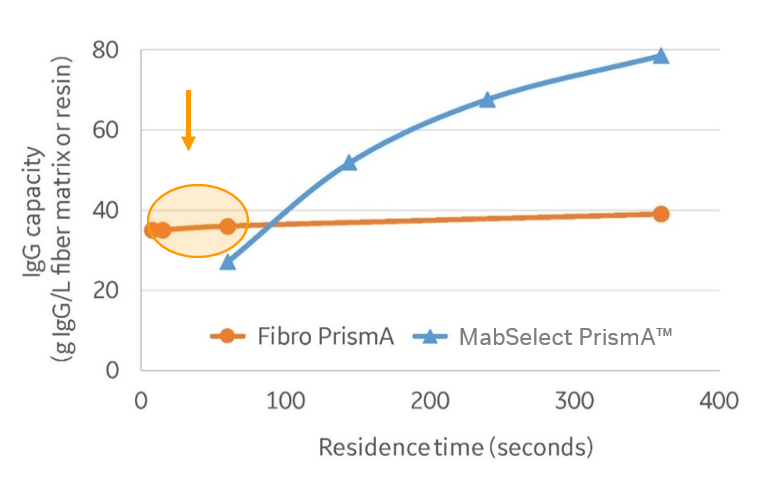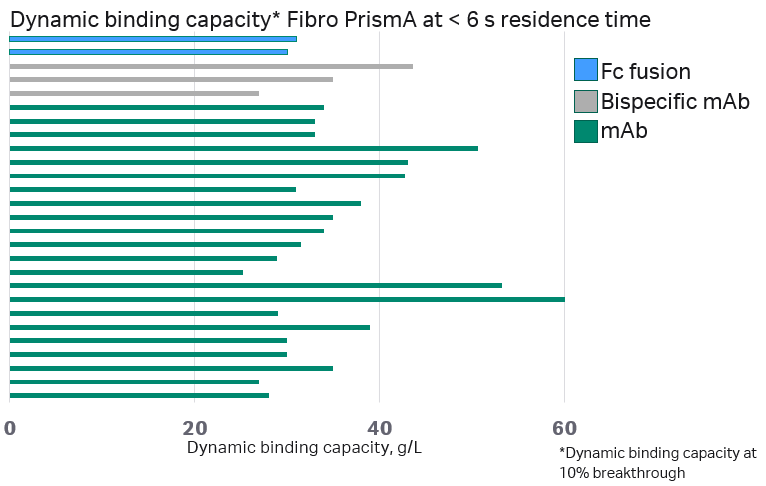Note: Looking for our guide on DBC for resins? You can find it here: How to determine dynamic binding capacity (DBC) of chromatography resins
Fiber-based matrices for affinity purification have several advantages over resins, including their suitability for rapid-cycling chromatography. Fiber chromatography matrices such as Fibro PrismA can bind a large amount of protein in a fraction of the purification time required for an affinity resin. Just like with resins, the dynamic binding capacity (DBC) of a Fibro unit is affected by process conditions and by the properties of the target molecule. Thus, determining the DBC of a Fibro unit is still a key step in your process.
Calculating mAb load and matrix needs
You’ll need to know the DBC to calculate the mAb load for your chromatography step. The load is typically 80% of the capacity at 10% breakthrough. For Fibro PrismA, the margin of 80% allows for variation in DBC between individual units and avoids yield losses due to the decrease in capacity over the large number of cycles.
DBC also helps you determine how much matrix — whether resin or Fibro units — is required to purify a given amount of protein. In other words, protein binding capacity determines how much protein can be purified by a given volume or mass of Fibro matrix or resin.
DBC in Fibro PrismA units
In general, we see high DBC, independent of the flow rate, for Fibro PrismA units. The limitations of chromatography resins are their pressure/flow characteristics and binding capacity, where mass transfer is limited by diffusion into the particles. With Fibro PrismA, DBC is consistent regardless of flow rate, as shown in Figure 1.

Fig 1. IgG binding capacity as a function of residence time for Fibro PrismA and MabSelect PrismA™ chromatography resin.
DBC is around 30 g/L for HiTrap Fibro™ and HiScreen Fibro™ PrismA chromatography units, with some variation depending on the molecule. When we tested Fibro PrismA for capture of fusion proteins, bispecific antibodies, and monoclonal antibodies, we observed DBCs in the range of 25 to 60 g/L, as shown in Figure 2.

Fig 2. DBC (g/L) of Fibro PrismA for Fc fusion protein, bispecific monoclonal antibody (mAb) and mAb at 10% breakthrough and < 6 s residence time.
How do I determine DBC of Fibro PrismA for my molecule?
Here are some tips to help you get started with determining DBC (differences may apply depending on which ÄKTA™ chromatography system you’re using):
- Disconnect the mixer chamber to reduce the ÄKTA™ system hold-up volume.
- Set the pre-column pressure limit to 1.0 MPa in UNICORN™ software.
- By-pass the flow restrictor in the method to reduce the pressure.
- Set noise reduction/UV averaging time to 0.2 s.
- Remove any pump washes/fill system instructions in the method, as the previous buffer is chased by the next buffer.
- If you’re using a pre-purified molecule to determine the DBC, dilute your sample in a buffer with a higher salt concentration than your equilibration buffer. Use the 50% shift in conductivity to determine the unit delay volume. Delay volume ≠ unit volume.
You can find detailed instructions for determining DBC for Fibro PrismA units in HiTrap Fibro™ PrismA and HiScreen Fibro™ PrismA Instructions for Use.